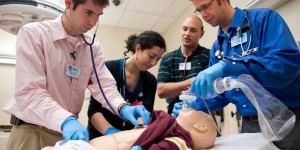The Clinical Learning Environment
This scholarly programme focuses on exploring and enhancing the clinical learning environment. Co-creation in medical education, particularly during clinical placements, fosters a sense of belonging, supports identity growth, and promotes social integration for students. Clinical debriefing is explored as a tool to improve team performance and patient safety, with studies highlighting challenges to implementation and advocating for routine use in clinical settings. Lastly, understanding how safe care is enacted by medical registrars emphasises the role of system design, culture, and collaboration.
Co-Creation of Learning
From Corners to Community: Exploring medical students' sense of belonging through co-creation in clinical learning
This study explores how medical students experience co-creation of learning resources within a clinical environment, specifically in a paediatric unit. Through semi-structured interviews and interpretative phenomenological analysis, three themes were developed: identity maturation, learning community, and workplace integration. Co-creation helped students develop a sense of belonging, supported identity growth, and promoted social integration, highlighting its potential as a participatory learning method.
'More part of the team': co-creating during paediatric placements
This article explores the concept of co-creation, where medical students actively participate in the learning process, and its role in promoting a sense of belonging, particularly during paediatric placements. It evaluates the use of co-creation in clinical learning environments and offers practical advice for clinicians and educators to implement this approach in their own teaching. Co-creation is highlighted as a relational method that supports student development and well-being in medical education.
Clinical Event Debriefing
Overcoming barriers to clinical event debriefing through simulation
This study addressed the lack of routine Clinical Event Debriefing (CED) in medical practice by testing whether immersive simulation could overcome barriers such as unclear purpose, lack of skills, time constraints, and culture. A novel simulation involving an obstetric emergency followed by a participant-led CED using the STOP5 tool was piloted with medical registrars. Participants reported increased confidence in leading CEDs and recognised the value of CED for improving team performance and patient safety. Despite being resource-intensive, immersive simulation was found to be an effective method for training CED, fostering cultural change toward making CED standard practice.
Podcast: Clinical Debriefing
(link to: /show/clinical-conversations/clinical-debriefing-08-apr-2024/)
In this episode, two members of the MED team chat about clinical debriefing. They talk about what clinical debriefing is (and isn’t) and why we should be incorporating this into our everyday work. They explore when and how to facilitate a clinical debrief and share tips on how we can embed clinical debriefing into our practice.
Systematic review of clinical debriefing tools: attributes and evidence for use
This systematic review aimed to identify tools for clinical debriefing (CD) and assess their attributes and evidence for use. It found 21 tools designed for acute care settings, most providing guidance on facilitator roles, psychological safety, and education, but few detailing processes for implementing change. While many tools demonstrated some evidence for use, only one showed improved patient outcomes. The review recommends further research to better evaluate the impact of CD tools on individuals, teams, and patient care.
Routine versus prompted clinical debriefing: aligning aims, mechanisms and implementation
This article explores the value of clinical debriefing (CD) and the challenges of its implementation in healthcare. Despite evidence supporting CD's benefits for staff and patient outcomes, barriers such as unclear purpose, time constraints, and cultural resistance hinder its widespread adoption. It discussed a proposed new categorisation of CD into "routine" and "prompted" debriefs, aiming to replace ambiguous terms like "hot" and "cold" debriefs. The article also calls for further research on the impact of emotions, culture, and context on CD practices.
Development and validation of the theatre team tool (TTT): A clinical debriefing tool for multidisciplinary theatre teams
This study aimed to design and validate a clinical debriefing (CD) tool specifically for multidisciplinary theatre teams. The "Theatre Team Tool" (TTT) was developed through expert reviews and validated for content and face validity, offering flexibility to debrief with a focus on either learning or managing outcomes. The tool achieved high scores for clarity and relevance, making it the first validated CD tool for theatre teams. The next step is to promote its implementation, which could significantly benefit theatre teams and improve patient outcomes.
Educating for Safety
Safety on the ground: using critical incident technique to explore the factors influencing medical registrars’ provision of safe care
This study explored factors influencing patient safety from the perspective of medical registrars using enhanced critical incident technique (CIT). Interviews with registrars identified 221 critical incidents, categorised into four areas: individual skills, collaboration, organisation, and training environment. Key targets for improvement included fostering interprofessional collaboration, addressing organisational systems, promoting civility, and ensuring flexibility in care practices. The study emphasises the importance of system design, culture, and collaboration in improving hospital safety, and suggests targeted interventions in education and organisational practices.


